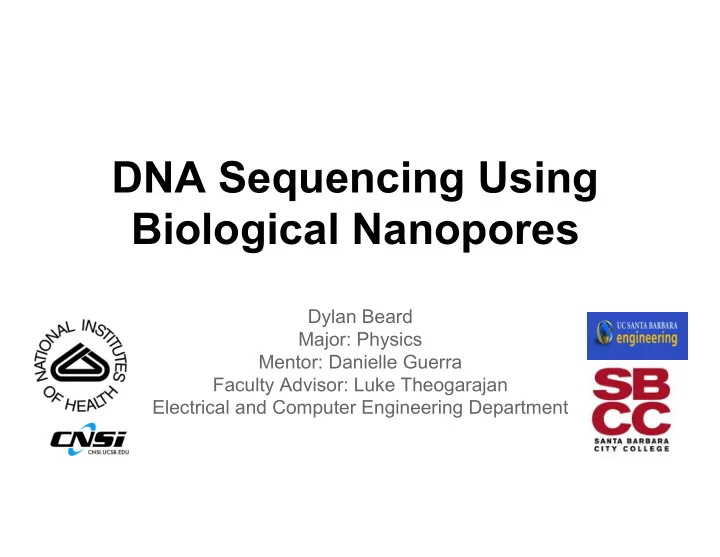

DNA Sequencing Using Biological Nanopores Dylan Beard Major: Physics Mentor: Danielle Guerra Faculty Advisor: Luke Theogarajan Electrical and Computer Engineering Department
Conventional DNA sequencing Nobel Prize in Chemistry, 1980. Sanger Method: As DNA is synthesized, nucleotides are added onto the growing chain by DNA polymerase.
Ahh, much better! Image: Venkatesan et al , Nature Nano
Nanopores for DNA sequencing ➢ Fast and cheap sequencing ➢ Can reveal predispositions to a variety of illnesses Current Technology VS. ➢ Technology may go from: lab → industry → clinic → household → ?? Nanopore Technology ➢ Multidisciplinary research (potentially) Image: Oxford Technologies
So how does it work? Protein pore polymer membrane ● DNA passes through and creates a blockade of current
Polymer Membranes as the Platform Goal #1: Form polymer ● membranes ● Highly Stable ● Long-Lasting instead of... lipid membrane ● Very Fragile! ● Limited lifetime Image: Courtesy of Dr. Luke Theogarajan
Proteins behave differently in polymer membranes Certain bilayer properties can give rise to certain protein conformations Different protein shape = different protein function. Image: Bowie, J.U., “Solving the memrane protein folding problem,” Nature 438, 581-589.
Gramicidin A as a Molecular Force Probe Goal #2: Use Gramicidin A, a peptide, to probe membrane properties and understand membrane energetics Image: Andersen O. S., Koeppe R. E. II 2007 Bilayer thickness and membrane protein function: an energetic perspective. Annu. Rev. Biophys. Biomol. Struct. 36, 107–130.
Methods 1. Making membranes 2. Inserting Gramicidin A
Forming Membranes The setup . Teflon Aperture Vacuum grease in this 50 um hole in this area area
Apply a voltage to form the membrane + and the Amplifier sensitive to very small result... current levels (picoamp range) 50 µm
Inserting Gramicidin A Form membrane (make sure it’s stable!) under applied voltage Pipet Gramicidin A near aperture Look for characteristic current traces
Results 1. Stable membranes 2. Protein insertion
Results: Formed Membranes 50 µm Membranes 100 µm (Webcam view)
Model membrane as a parallel plate capacitor Bilayer thickness Membrane hydrophobic region
Membrane Thinning dielectric ● As membrane thins, capacitance values increase = indicative of stability
Results: Protein Insertion Protein insertion at 180mV Stepwise conductance increase characteristic of insertion We predict gramicidin will have a similar transition, but with lower values
Summary of Progress ➔ Refining protocol for gramicidin assay ➔ Learned prep work for membrane formation ➔ Learned how to form membranes under applied voltage
Future of Research Continue with gramicidin study to optimize polymer/protein interaction Long term: Nanopore array- allows high throughput sequencing
Acknowledgements Special thanks to … -The INSET Group & Staff -Danielle Guerra -Professor Luke Theogarajan -Dr. “Bob” Mortezaei -Daniel Apodoca -Mr. Paul Kovacs
Recommend
More recommend